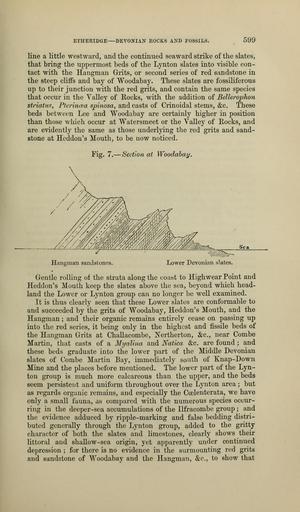MAKE A MEME
View Large Image

| View Original: | The_Quarterly_journal_of_the_Geological_Society_of_London_(13071243313).jpg (1211x2069) | |||
| Download: | Original | Medium | Small | Thumb |
| Courtesy of: | commons.wikimedia.org | More Like This | ||
| Keywords: The Quarterly journal of the Geological Society of London (13071243313).jpg ETHE RIDGE DEYONIAI ROCKS AND FOSSILS <br> 599 <br> line a little westward and the continued seaward strike of the slates <br> that bring the uppermost beds of the Lynton slates into visible con- <br> tact with the Hangman Grits or second series of red sandstone in <br> the steep cliffs and bay of Woodabay These slates are fossiliferous <br> up to their junction with the red grits and contain the same species <br> that occur in the Valley of Eocks with the addition of Bellerojphon <br> striatus Fterincea spinosa and casts of Crinoidal stems c These <br> beds between Lee and Woodabay are certainly higher in position <br> than those which occur at Watersmeet or the Valley of Rocks and <br> are evidently the same as those underlying the red grits and sand- <br> stone at Hcddon's Mouth to be now noticed <br> Fig 7 ” Section at Woodabay <br> Hangman sandstones <br> Lower Devonian slates <br> Gentle rolling of the strata along the coast to Highwear Point and <br> Heddon's Mouth keep the slates above the sea beyond which head- <br> land the Lower or Lynton group can no longer be well examined <br> It is thus clearly seen that these Lower slates are conformable to <br> and succeeded by the grits of Woodabay Heddon's Mouth and the <br> Hangman ; and their organic remains entirely cease on passing up <br> into the red series it being only in the highest and fissile beds of <br> the Hangman Grits at Challacombe Nertherton c near Combe <br> Martin that casts of a Myalina and Natlca c are found ; and <br> these beds graduate into the lower part of the Middle Devonian <br> slates of Combe Martin Bay immediately south of Knap-Down <br> Mine and the places before mentioned The lower part of the Lyn- <br> ton group is much more calcareous than the upper and the beds <br> seem persistent and uniform throughout over the Lynton area ; but <br> as regards organic remains and especially the Coelenterata we have <br> only a small fauna as compared with the numerous species occur- <br> ring in the deeper-sea accumulations of the Ilfracombe group ; and <br> the evidence adduced by ripple-marking and false bedding distri- <br> buted generally through the Lynton group added to the gritty <br> character of both the slates and limestones clearly shows their <br> littoral and shallow-sea origin yet apparently under continued <br> depression ; for there is no evidence in the surmounting red grits <br> and sandstone of Woodabay and the Hangman c to show that 36345362 112028 51125 Page 599 Text v 23 http //www biodiversitylibrary org/page/36345362 1867 Geological Society of London NameFound Coelenterata NameConfirmed Coelenterata EOLID 1745 NameBankID 9716364 NameFound Combe NameConfirmed COMBE EOLID 12397 NameBankID 4122786 NameFound Fterincea spinosa NameFound Myalina NameConfirmed Myalina NameBankID 4249388 Biodiversity Heritage Library The Quarterly journal of the Geological Society of London v 23 1867 Geology Periodicals Smithsonian Libraries bhl page 36345362 dc identifier http //biodiversitylibrary org/page/36345362 smithsonian libraries Information field Flickr posted date ISOdate 2014-03-10 Check categories 2015 August 26 CC-BY-2 0 BioDivLibrary https //flickr com/photos/61021753 N02/13071243313 2015-08-26 13 51 33 cc-by-2 0 PD-old-70-1923 The Quarterly journal of the Geological Society of London 1867 Photos uploaded from Flickr by Fæ using a script | ||||